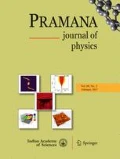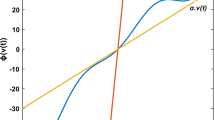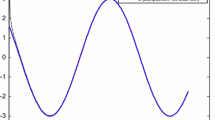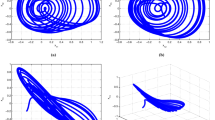Abstract
A novel model-free adaptive sliding mode strategy is proposed for a generalized projective synchronization (GPS) between two entirely unknown fractional-order chaotic systems subject to the external disturbances. To solve the difficulties from the little knowledge about the master–slave system and to overcome the bad effects of the external disturbances on the generalized projective synchronization, the radial basis function neural networks are used to approach the packaged unknown master system and the packaged unknown slave system (including the external disturbances). Consequently, based on the slide mode technology and the neural network theory, a model-free adaptive sliding mode controller is designed to guarantee asymptotic stability of the generalized projective synchronization error. The main contribution of this paper is that a control strategy is provided for the generalized projective synchronization between two entirely unknown fractional-order chaotic systems subject to the unknown external disturbances, and the proposed control strategy only requires that the master system has the same fractional orders as the slave system. Moreover, the proposed method allows us to achieve all kinds of generalized projective chaos synchronizations by turning the user-defined parameters onto the desired values. Simulation results show the effectiveness of the proposed method and the robustness of the controlled system.





Similar content being viewed by others
References
D Ingman and J Suzdalnitsky, J. Vib. Acoust. 124, 642 (2002)
M Ichise, Y Nagayanagi and T Kojima, J. Electroanal. Chem. 33, 253 (1971)
H H Sun, A A Abdelwahad and B Onaral, IEEE T. Automat. Contr. 29, 441 (1984)
R C Koeller, Acta Mech. 191, 125 (2007)
S Dadras and H R Momeni, Physica A 389, 2434 (2010)
Y J Yang, C C Chen, P Y Lai and C K Chan, Phys. Rev. E 92, 030701 (2015)
S Bhalekar and V Daftardar-Gejji, Commun. Nonlinear Sci. Numer. Simul. 15, 3536 (2010)
L Pan, W Zhou, L Zhou and K Sun, Commun. Nonlinear Sci. Numer. Simul. 16, 2628 (2011)
D Cafagna and G Grassi, Nonlinear Dyn. 68, 117 (2012)
X Wang, X Zhang and C Ma, Nonlinear Dyn. 69, 511 (2012)
D Liu and X M Yan, Acta Phys. Sin. 58, 3747 (2009)
A E Matouk, Commun. Nonlinear. Sci. Numer. Simul. 16, 975 (2011)
S Wang and Y Yu, Chin. Phys. Lett. 29, 020505 (2012)
L Wang et al, Chin. Phys. B 23, 100501 (2014)
Y Yu and H Li, Nonlinear Anal. 11, 2456 (2010)
D Sun, X Shao and G Feng, IEEE Trans. Control Systems Technol. 15, 306 (2007)
R Martínez-Guerra, W Yu and E Cisneros-Saldana, Chaos, Solitons and Fractals 36, 1141 (2008)
R Aguilar-López and R Martı, Chaos, Solitons and Fractals 38, 531 (2008)
P Faradja and G Qi, Robustness based comparison between a sliding mode controller and a model free controller with the approach of synchronization of nonlinear systems, 15th International Conference on Control, Automation and Systems (Busan, Korea, Oct. 13–16, 2015)
Y Li, Y Q Chen and I Podlubny, Comput. Math. Appl. 59, 1810 (2010)
J K Liu, Intelligence control (Beijing Publishing House of Electronic Industory, 2005)
E J Hartman, J D Keeler and J M Kowalski, Neural Comput. 2, 210 (1990)
J Park and I W Sandberg, Neural Comput. 3, 246 (1990)
M Anthony and P L Bartlett, Neural network learning (Cambridge University Press, Cambridge, 2009)
G Feng, Robot. Auto. Syst. 15(3), 199 (1995)
J J E Slotine and W Li, Applied nonlinear control (Prentice-Hall, Englewood Cliffs, 1991)
K Konishi, M Hirai and H Kokame, Phys. Lett. A 245, 511 (1998)
I Grigorenko and E Grigorenko, Phys. Rev. Lett. 91, 034101 (2003)
C Li and G Chen, Chaos, Solitons and Fractals 22, 549 (2004)
W Deng, J. Comput. Phys. 227, 1510 (2007)
Acknowledgements
The authors are very grateful to the reviewers for their valuable comments and suggestions, which have led to the improved presentation of this paper. This work was partially supported by the Projects of Department of Science and Technology in Hebei Province, China (Grant No. 15213401), the Research Foundation of Education Bureau of Hebei Province, China (Grant No. QN2014096) and the Langfang Teachers University Foundation, China (Grant No. LSLZ201404).
Author information
Authors and Affiliations
Corresponding author
Appendix: Dynamic equations of the fractional-order chaotic systems
Appendix: Dynamic equations of the fractional-order chaotic systems
The fractional-order chaotic Lorenz system [28] is described by the following equation:
Through numerical simulations, one can find that system (A.1) will exhibit chaotic behaviours when \((q_1 ,q_2 ,q_3 )=(0.98,0.95,0.97)\), which is shown in figure 6.
The fractional-order chaotic Chen system [29] is described by the following equation:
Through numerical simulations, one can find that system (A.2) will exhibit chaotic behaviours when \((q_1 ,q_2 ,q_3 )=(0.98,0.95,0.97)\), which is shown in figure 7.
Rights and permissions
About this article
Cite this article
Wang, L.M. Model-free adaptive sliding mode controller design for generalized projective synchronization of the fractional-order chaotic system via radial basis function neural networks. Pramana - J Phys 89, 38 (2017). https://doi.org/10.1007/s12043-017-1434-8
Received:
Revised:
Accepted:
Published:
DOI: https://doi.org/10.1007/s12043-017-1434-8
Keywords
- Generalized projective chaos synchronization
- model-free control
- neural sliding mode control
- fractional-order chaotic system






